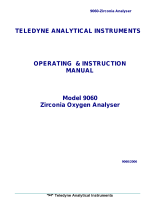
October 2016
TN02 520-1001 Rev 3
Technical note
MTL gas analysers & systems
Eaton Electric Limited,
Great Marlings, Butterfield, Luton
Beds, LU2 8DL, UK.
Tel: + 44 (0)1582 723633 Fax: + 44 (0)1582 422283
www.mtl-inst.com
© 2016 Eaton
All Rights Reserved
Publication No. TN02 520-1001 Rev 3
October 2016
Using MTL Zirconia Oxygen Analysers to
Measure the Dewpoint of Furnace Atmospheres
A MTL Zirconia Oxygen Analyser will measure dewpoint
only under certain conditions:
1) that the gas to be measured contains a known amount
of hydrogen;
2) that the balance of the gas is either nitrogen or inert.
As a result it works in pure hydrogen, cracked ammonia,
and hydrogen/argon or hydrogen/helium mixtures, but
not in carburising gases, which also contain CO/CO2,
although very useful measurements can be made in these
atmospheres too - see Technical Note TN03.
In order to appreciate the advantages of using MTL zirconia
oxygen analysers to monitor furnace atmospheres, it is helpful
to understand why in such atmospheres the dewpoint is
measured. The measurement of the dewpoint of a gas is, in
reality, just a way of measuring its water content. The reason
this is important is because too much water in the furnace
atmosphere will spoil the work going through it; not because
of the water itself but because, at the high temperatures within
a furnace, it dissociates into hydrogen and oxygen. This is
illustrated by the following chemical equation:
2H2O = 2H2+ O2
It is the oxygen that then reacts with the work in the furnace
causing staining or scaling. At any given temperature the ratio
p2[H2] x p[O2]
p2[H2O]
is a constant. (p is the concentration or activity of the reactant in
the bracket). Similar equations can be written to describe a metal
in equilibrium with oxygen. The values of the constants are well
defined by standard data. In fact, what is happening inside the
furnace is a kind of competition between the contents, say iron
and hydrogen, for the oxygen. At any particular temperature,
a metal will have a precise oxygen concentration, or activity,
at which it will oxidise. If the oxygen activity is kept below
that point, no oxidation will take place, and vice versa. What
the formula illustrates is that by adding more hydrogen to an
atmosphere, the oxygen activity is reduced. This is because
the only way the ratio of activities can be maintained constant,
as determined by the laws of chemistry, is by the oxygen
decreasing and/or the water increasing. Adding more hydrogen
is a standard cure for overcoming problems when the water
content (dewpoint) becomes too high.
This is why furnace operators always wanted the dewpoint to
be measured; because, in less enlightened times, it was the
only way to determine how much oxygen was in the furnace.
To avoid the complication of translating this figure into oxygen
concentration, the atmosphere quality used to be expressed in
terms of dewpoint and hydrogen concentration.
The key factor however is oxygen, and its activity, and MTL
zirconia oxygen analysers measure this directly. The zirconia
sensor is uniquely capable of measuring the extremely low
concentrations of oxygen to be found in these atmospheres.
For convenience, some analysers can be fitted with a meter
scaled in dewpoint. However there is no real reason to have the
analyser scaled in dewpoint; we offer it only because some
users are used to it. It could be scaled in parts per million of
water vapour, sensor millivolts or, more pedantically, in oxygen
potential; the figure that the user really needs to know.
Oxygen potential is no more than the oxygen activity expressed
in chemical units. As such it relates easily to the oxygen values
that a chemist would use when determining the point at which
a metal would oxidise at a particular temperature. All of our
microprocessor based analysers of this type display in oxygen
potential (kilo-calories or kilo-joules). See Technical Notes TN01
& TN03 for a fuller explanation of zirconia oxygen cell theory,
etc.


